Orthodontics is a specialty of dental medicine that focuses on monitoring, studying and directing the growth and development of the jaws and teeth, as well as correcting irregularities.
It is a lesser-known fact that orthodontics was the first officially recognised dental speciality. It is practised by dentists who, after six years of university studies, successfully complete an additional three-year specialist study and acquire the title of Doctor of Dental Medicine, Specialist in Orthodonics.
There is no age limit or orthodontics, patients of all ages can be successfully treated. In the past, we were focused on working with children, and fixed braces were an integral part of adolescence.
The modern way of life, as well as the beauty and health imperative, are making an increasing number of adult patients seek the help of an orthodontist. By aligning the teeth and improving the bite, we improve oral health and function. By harmonising the smile, we increase the self-confidence and general quality of life of all our patients.
The first orthodontic consultation should occur around child’s seventh birthday. Even when the parents feel that the child’s teeth are perfect “like a string of pearls” 😊, the bite may be such that it requires monitoring or early intervention.
A preliminary diagnosis can then be made, and we explain to the parents the nature of the malocclusion, the treatment options, and the age at which it should be carried out. If necessary, we suggest early interceptive treatment and recommend a schedule of check-ups for monitoring growth until the beginning of the next phase.
In no case should you leave the child’s first visit to the orthodontist “until all permanent teeth have erupted”. Sometimes baby teeth do not fall out and permanent ones do not erupt due to a serious issue that an orthodontist can recognise early enough. However, with the timely beginning of a correct treatment plan, we can ensure the eruption of all teeth without extraction and complications.
The timing of the treatment is just as crucial to success an appropriate treatment plan.
It is never a good idea to delay treatment because we can miss the opportunity to direct growth, to create space for aligning all permanent teeth and to create a gorgeous smile and thus avoid more complex treatment modalities. Even the teenager and the parents can be unaware that, for example, a permanent tooth has not erupted at all, but remains blocked in the bone. Sometimes, however, the anomaly is so pronounced that we must suggest extraction, which could have been avoided if we had started modelling growth a year and a half earlier.
On the other hand, it is a bad idea to start therapy too early, before our procedures can have result and the child is psychologically mature enough, all just to provide the child, and parents, with an appliance. In that case, when the time comes for the finishing touches, for which the patient’s cooperation is crucial, it is absent due to fatigue, exhaustion and loss of interest.
Today, it is clear that each child grows at a pace that may or may not match the statistical average and growth charts, and that the same anomaly can be differently pronounced, so each patient should be assessed individually for the proper timing of an individualised treatment plan. Still, we can say that for most malocclusions, the best time to begin treatment is between the ages of 8 and 14.
Determining the correct timing for the beginning of treatment requires the extensive experience and good ethical practice of the orthodontist.
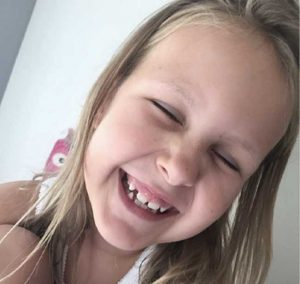
Interceptive treatment in young children begins in the mixed dentition stage (when the deciduous teeth fall out and the permanent teeth erupt). The goal of interceptive treatment is to correct irregularities that would otherwise lead to a much more significant problem later in life. Interceptive treatment is followed by either a pause with follow-up or we immediately start the precise correction of both teeth and intermaxillary relations with fixed appliances.
A space maintainer is an example of an interceptive procedure. Its purpose is to maintain the place for a permanent tooth if the baby tooth falls out too early due to caries or trauma. If there is no baby tooth to preserve its place, the permanent tooth that is still in the developmental stage will not have enough space to grow into because adjacent permanent teeth will have closed its space. Without a space maintainer, the permanent tooth would remain blocked in the bone or grow completely outside the dental arch.
Children often have a habit of sucking their thumb or pacifier. We then give instructions for myofunctional therapy (exercises) and help the child break the habit, which, if continued, would not only cause irregular tooth growth but also jaw deformation.
Additionally, with early intervention, we can avoid later tooth extraction, as well as correct and reverse an underbite (lower teeth over the upper ones) or crossbite, which would later lead to deformation of the jaw if left untreated.
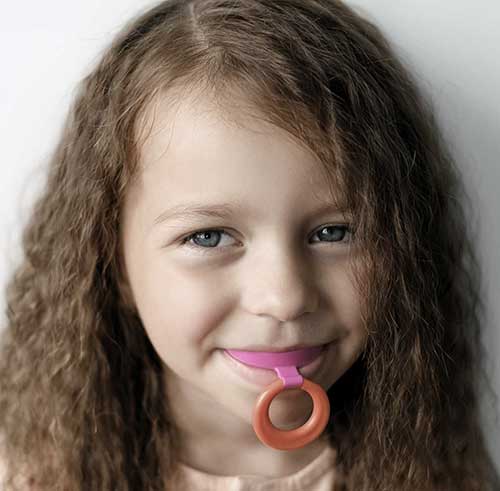
Corrective orthodontic treatment is carried out with orthodontic appliances. In some children, this means a comprehensive two-phase treatment, which involves a removable appliance followed by a fixed appliance, and in some children, we can start with a fixed appliance from the beginning.
There are two basic types of orthodontic appliances: removable appliances, which patients put on and take off themselves, and fixed appliances, or braces, which the orthodontist puts on, activates, and removes. The Hyrax and Delaire face masks are examples of extraoral removable appliances that we give to both children and adults, though with different purposes.

The headgear is an extraoral (external) appliance for children whose upper jaw grows too strongly in comparison with the lower jaw. In this case, although not always, the upper teeth protrude outwards, and space to for the posterior permanent teeth is often lacking. Headgear, inhibits the growth of the upper jaw by simultaneously moving the upper teeth backwards, which opens up space for the eruption of teeth that would otherwise remain “blocked” in the bone, i.e. that would not erupt at all (e.g. canines). The headgear is usually the first part of a two-phase comprehensive treatment, followed by a fixed appliance. Some patients continue to wear the headgear simultaneously with the fixed appliance. The combination of headgear and fixed appliance dramatically improves the appearance of the face and eliminates the need for tooth extraction to the satisfaction of the child, parents, and orthodontist.
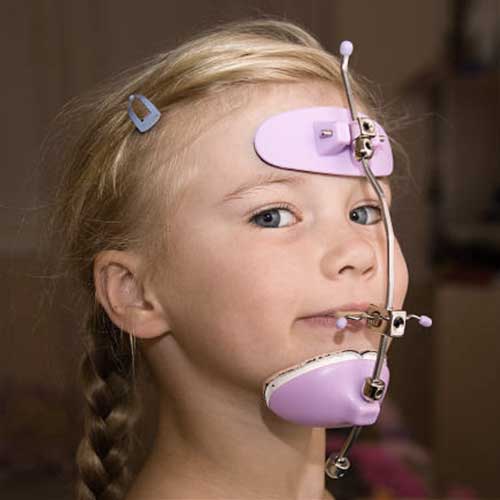
The so-called reverse pull face mask or reverse pull headgear is designed to have the opposite effect of the headgear. It is most often used in children with an underbite (the lower teeth overlap the upper ones). The upper lip is thin and flat, while the lower lip is thicker and more pronounced, making the profile appear concave. The cause of the problem is insufficient growth of the upper and/or excessive growth of the lower jaw. The face mask pulls the upper jaw and upper teeth forward by means of a fixed appliance, stimulating the growth of the jaw. Its skeletal effect is most evident in children under the age of 9, when it is often combined with a hyrax, an appliance for expanding the upper jaw. With the reverse pull face mask, it is possible to achieve forward movement of the upper jaw of up to 2 mm. After the age of 9, the skeletal effect is less, and the dental effect is more pronounced. Although it is primarily indicated in children, it can also be used in adult patients.
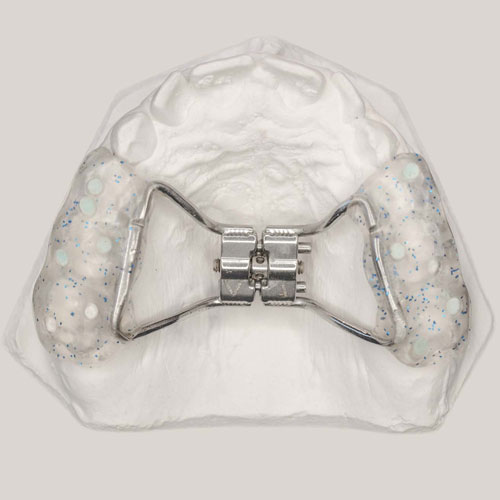
Hyrax je naprava za širenje gornje čeljusti.
The hyrax is an appliance for expanding the upper jaw. As a rule, it is used in growing children whose upper jaw is not wide enough in relation to the lower. This can be seen in the fact that the lower posterior teeth embrace the upper ones, instead of the other way around, and the space for all the teeth to align is lacking (resulting in crowding). The appliance achieves both a skeletal (expansion of the maxilla) and dental (outwards movement of the teeth and alveolar bone) effect. The hyrax is often combined with the reverse pull face mask, expanding the maxilla, and stimulating it to grow forward.
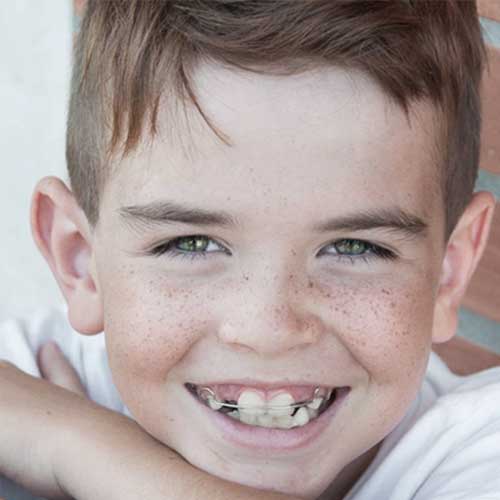
Removable appliances are further divided into monomaxillary and bimaxillary. Monomaxillyry appliances are used on one of the jaws, while bimaxillary appliances are used in both the maxilla and mandible at the same time. They direct and model the growth of the jaw and to some extent influence the position of the teeth.

Quality of life can be described as a self-reported overall well-being. Maligned teeth and a bad bite may negatively affect essential functions like speech and chewing, maintaining oral hygiene, and impairing periodontal health.
Additionally, malocclusions have been shown to have a markedly negative impact on overall quality of life as they damage self-esteem, thereby adversely affecting social interactions, private life, and professional success. As health and beauty, and thus self-perceived satisfaction with life, are largely conditioned by a beautiful smile, an increasing number of adult patients decide to have “straight and beautiful teeth”.
There is no age limit for orthodontic treatment. The biomechanics of tooth movement are the same in adults and children. Regardless of age, orthodontic treatment can correct protruding and retruded teeth, open up the space to align teeth that have erupted outside the dental arch, open the bite, and close gaps caused by tooth extraction at an earlier age and thus eliminate the need for bridges or implants. Appliances of choice for adult patients are fixed orthodontic appliances and Invisalign®, depending on the type and complexity of the anomaly, as well as the patient’s preferences.
Malocclusions can be corrected at any age. The latest data shows that as many as 50 % of orthodontic patients are adults. Adult patients are conscientious, highly motivated and if the orthodontist, acknowledging patients’ widhes while following all the professional norms, sets a clear and realistic treatment plan, they can achieve fantastic results.
In the last 20, Dr. Vidaković has successfully treated many patients of all ages, and it is always great fun when braces are worn by three generations of the same family at the same time (granddaughter / grandson, mom / dad, grandma / grandpa). 😊
Adult patients wear orthodontic appliances with the desire to improve their oral health, brighten their smiles and improve their quality of life because now it’s their turn!
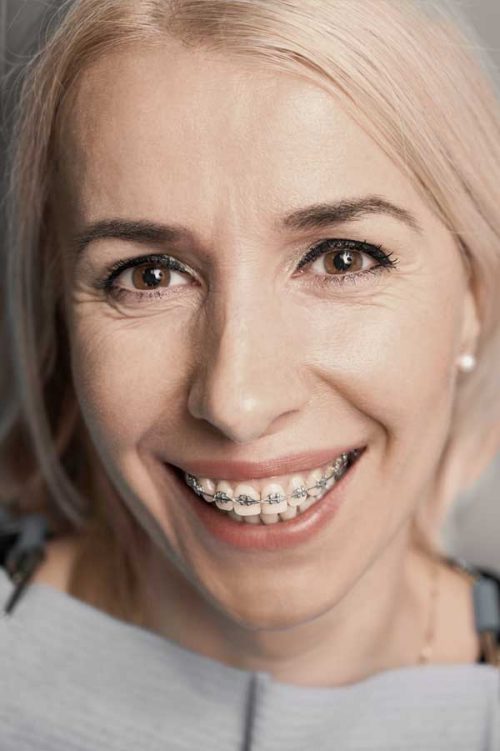
Fixed orthodontic appliance (braces) is the most common and the most effective mean of correcting malocclusions.
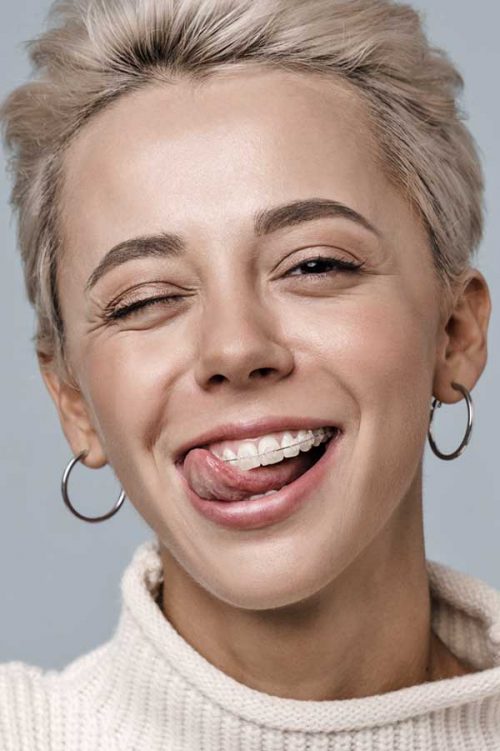
Aesthetic, almost invisible brackets widely accepted among both children and adults, are a symbol of health and self-improvement.
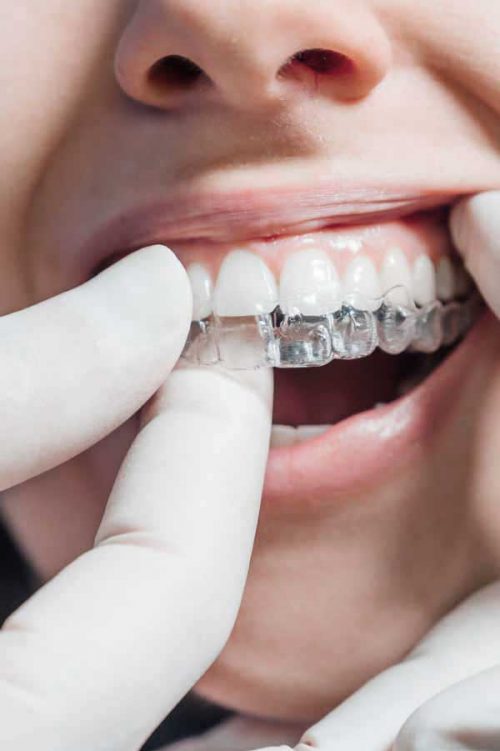
Invisalign® is a reliable and aesthetically superior method of straightening the teeth with clear aligners.
Patients are often referred to an orthodontist by dentists and specialists in other disciplines like periodontists or prosthodontists.
The treatment plan of complex cases includes several coordinated procedures performed by specialists in different disciplines, hence the name “interdisciplinary treatment”. The goal of the orthodontic part of an interdisciplinary treatment is to align teeth in optimal positions to maintain oral hygiene, enable bridge and implant placement, or the placement of veneers. Without orthodontic treatment, later stages would not be possible, or their outcome would not be optimal and long-lasting.
Orthognathic or orthodontic-surgical treatment is performed when the malocclusion is so pronounced that it cannot be corrected with orthodontics alone.
The most common malocclusion treated surgically is mandibular prognathism. The symptoms include the lower teeth overlapping the teeth of the upper jaw, instead of the other way round, a concave profile, a thin upper lip, and a protruding chin. The anomaly is hereditary. The intensity of mandibular growth cannot be reduced, we have no way to stop its growth, any more than we can stop the growth of, for example, the feet or nose.
When diagnostics and family history show that that orthodontic tooth movement and the orthopaedic stimulation of maxillary growth (pseudo-prognathism) alone cannot compensate for the skeletal and dental discrepancy and when it is not possible to achieve a satisfactory functional and aesthetic result, a plan for a combined orthodontic-surgical treatment is set in motion.
The orthodontic treatment starts at the end of the patient’s growth and surgery is performed after the patient has stop growing altogether. In the “surgery-first” approach the first step is orthodontic decompensation using a fixed appliance: aligning the teeth in the corresponding jaw, regardless of the intermaxillary relations. This often further emphasises the dentofacial deformity, so patients have the impression that we are making things worse, but we are actually positioning the teeth to make possible for the jaws to be surgically repositioned to a functional bite and pleasing facial appearance. In coordination with the maxillofacial surgeon, we simulate the movement of one or both jaws and make acrylic templates. The orthodontic treatment is continued after the operation and recovery, for detailing the occlusion and perfecting the bite.
Not many facial procedures result in such significant changes in appearance as orthognathic surgery. The changes in appearance are dramatic and patients, as well as their close ones, must be psychologically prepared. The motivation for this type of treatment is not only the desire to improve function, but also to achieve a harmonious and beautiful appearance, and thus a better and more fulfilling life.
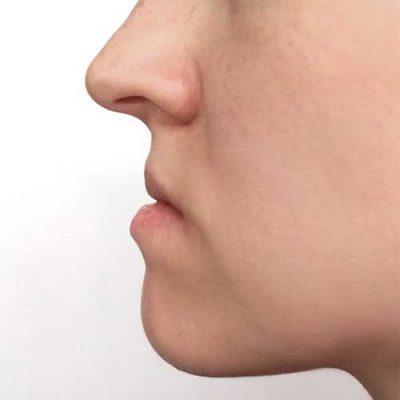
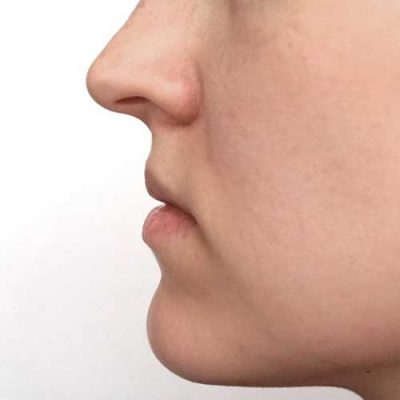
The psychological preparation of the patient, the expertise of the physician and good communication between the orthodontist, the patient and the maxillofacial surgeon are key to the success of interdisciplinary therapy with such far-reaching consequences.
Ortodoncija Vidaković
Cankareva 21, 10 000 Zagreb